Public Opinion Spread and Guidance Strategy under COVID-19: A SIS Model Analysis
Abstract
:1. Introduction
2. Literature Review
| Literature | Year | Content Analysis or Emotional Analysis a | Emotional Types b | Static/Dynamic Data c | Stakeholders d | Model e |
|---|---|---|---|---|---|---|
| Reference [4] | 2021 | 1 | - | 1 | 1,2,3 | 3 |
| Reference [5] | 2020 | 1 | - | 2 | 1 | - |
| Reference [6] | 2022 | 1 | - | 2 | 1 | 4 |
| Reference [7] | 2020 | 1 | - | 1 | 1 | 4 |
| Reference [8] | 2021 | 1 | - | 1 | 2 | - |
| Reference [9] | 2022 | 1 | - | 2 | 1 | - |
| Reference [10] | 2021 | 1 | - | 1 | 1 | - |
| Reference [11] | 2015 | 1 | - | 2 | 1 | 1 |
| Reference [12] | 2020 | 1 | - | 2 | 1 | 2 |
| Reference [13] | 2017 | 1 | - | 2 | 1 | 1,2 |
| Reference [14] | 2020 | 2 | 1,2,3 | 1 | 1,2 | - |
| Reference [15] | 2021 | 2 | 1,2 | 2 | 1 | 3 |
| Reference [16] | 2013 | 1,2 | 1,2 | 1 | 3 | - |
| Reference [17] | 2020 | 1,2 | 1,2,3 | 1 | 1,3 | - |
| Reference [18] | 2021 | 1,2 | 1,2 | 2 | 1 | 4 |
| Reference [19] | 2020 | 1,2 | 1,2,3 | 2 | - | 3 |
| Reference [20] | 2020 | 1,2 | 1,2,3 | 2 | 1,2 | - |
| Reference [21] | 2020 | 1,2 | - | 1 | 1 | - |
| Reference [22] | 2021 | 1,2 | 1,2,3 | 2 | - | - |
| Reference [23] | 2021 | 1,2 | 1,2,3 | 2 | 1,3 | 4 |
| Reference [24] | 2017 | - | - | 2 | - | 1 |
| Reference [25] | 2014 | - | - | 2 | - | 1 |
| Reference [27] | 2021 | - | - | 2 | - | 1,4 |
| This paper | 2022 | 1,2 | 1,2,3 | 2 | 1,2,3 | 1 |
- (1)
- The majority of the extant literature on emotion analysis focuses on content analysis [4,5,6,7,8,9,10,11,12,13], emotional analysis [14,15], and the combination of content and emotional analysis [16,17,18,19,20,21,22,23]. In these literatures, neutral emotion analysis is often ignored. Positive, negative, and neutral emotion analysis is the focus of this paper compared with sources [15,16,18]. Meanwhile, dynamic data is analyzed by the combination of content analysis and emotional analysis in this work, which is different from Tu and Liu [14] and Hung et al. [17].
- (2)
- Government authorities are prevalent in the existing literature as targets for policy delivery except for Tang and Cai [8] and Stieglitz and Dang-Xuan [16]. The strategic direction ignores the combined role of the media platforms and users in guiding public opinion. At the same time, factors such as media technology and user literacy have not been considered. Media technology refers to communication technology, which is the technical means adopted by people for information dissemination, for example, the algorithm used in the Sina Weibo platform. Media literacy refers to a capacity for information selection, questioning, comprehension, evaluation, creation and production, and critical reaction abilities displayed by people in the face of media information. In this paper, suggestions for the government, media, and users are studied combining factors such as current media technology and user literacy.
- (3)
- An empirical approach [5,6,10,14,16], or quantitative research such as the LDA model [4,15,19], SIS model [11,24,25], and SIR model [12], are popularly used to investigate the emotional characteristics of COVID-19 public opinion dissemination in the existing literature. In the aforementioned studies, Wang and Cai [11], Suo and Guo [24], and Kandhway and Kuri [25] do not carry out an empirical analysis or case study. Moreover, the network analysis method used to study the COVID-19 public opinions is ignored. In this paper, we combine the optimized SIS model, an empirical study, and a network analysis method to study the emotional evolution characteristics of COVID-19 public opinion.
3. COVID-19 Public Opinion Dissemination Model
3.1. Model Assumptions and Parameter Setting
3.2. Model Formulation
3.3. Model Analysis
3.4. Simulation Analysis
4. Empirical Study
4.1. Data Sample
4.2. Emotion Analysis
4.3. Network Analysis
5. Conclusions and Recommendations
- (1)
- The government authorities should establish a public opinion risk evaluation and an early warning mechanism. In the face of COVID-19 public opinion, emotional value judgment should be made, and the questions and concerns of the hot search list should be actively addressed. It is necessary to actively guide negative public opinion, reduce its spreading speed, and prevent its outbreak. At the same time, the public opinion should be monitored, and the high-spreading nodes should be prevented to master the dominance of the public opinion prevention through a risk-based early warning mechanism. In addition, the government authorities should also pay attention to the rationality of public opinion research and judgment mechanisms. A one-size-fits-all approach to negative public opinion should be prevented. The relationship between public opinion supervision and citizens’ right to free speech should be balanced. The research and judgment mechanism should adopt the form of “algorithmic + artificial”. The normal emotional expression of the netizens and the criticism and suggestion of government measures should not be included. Such an approach is conducive to making decisions to reflect democracy, shaping the image of a democratic and service-oriented government and improving the cohesion of the “official and public” fight against COVID-19.
- (2)
- Platforms should strengthen public opinion supervision and users should improve their media literacy. Platforms can guide the public opinion by setting a hot search list through reasonable monitoring. Based on the characteristics of the Weibo platform, we should strengthen the monitoring of the COVID-19 public opinion on the Weibo platform and establish a microblog text-based sentiment analysis mechanism to forecast users’ emotional tendencies. The monitoring data should be fed back to government authorities in a timely manner to improve the response speed of government authorities. The government authorities can play a “cleaning” or “mitigating” role in the early stage of the negative public opinion by actively responding to the questions and concerns of the hot search list. In addition, the platforms should use algorithms reasonably to prevent the emergence of “algorithmic black boxes” and “algorithmic audiences” [32]. The platforms should focus on the public interest and shape it into a bridge that connects the government and the public. In addition, users should strengthen their media literacy. They should avoid getting caught up by the spread of the emotions of others and becoming boosters of the spreading of negative emotions. The ability to distinguish and criticize information should be improved, and rumors should not be easily believed or spread.
- (3)
- The media organizations should insist on positive reporting, improve social cohesion, and guide the trend of the public opinion. During the COVID-19 pandemic, mainstream media at all levels reported actively on the anti-epidemic spirit, medical workers, and other staff who adhered to the anti-epidemic posts. The mainstream media should gather the forces of all parties in the society to strengthen the appeal of positive publicity, and to guide the transformation of the negative public opinion. The content of information that is released by media organizations is authoritative, authentic, and spread widely. When negative public opinion prevails, media organizations should use their unique advantages to guide the influence of public opinion. Media organizations or government authorities should open channels to refute rumors and form a joint government–media guidance force from among the government, the media, and the public. For example, the Dongguan Internet Rumors Refusal Alliance was established by Nanfang Daily, Yangcheng Evening News, Dongguan Daily, Guangzhou Daily, Nanfang Metropolis Daily, and other mainstream newspapers, together with the Dongguan Internet Culture Association and related units. Regarding the news reports about COVID-19, the alliance gave timely and correct guidance concerning rumors and prevented public opinion from entering a stage of high-risk spread.
Author Contributions
Funding
Data Availability Statement
Acknowledgments
Conflicts of Interest
References
- Zhao, J.; Wu, W.; Zhang, X.; Qiang, Y.; Liu, T.; Wu, L. A short-term trend prediction model of topic over Sina Weibo dataset. J. Comb. Optim. 2014, 12, 613–625. [Google Scholar] [CrossRef]
- Zu, Z.; Jiang, M.; Xu, P.; Chen, W.; Ni, Q.; Lu, G. Coronavirus Disease 2019 (COVID-19): A Perspective from China. Radiology 2020, 296, 200490. [Google Scholar] [CrossRef] [PubMed] [Green Version]
- WHO. Director-General’s remarks at the 2019 Novel Coronavirus Media Briefing on 11 February 2020. Available online: https://www.who.int/zh/dg/speeches/detail/who-director-general-s-remarks-at-the-media-briefing-on-2019-ncov-on-11-february-2020 (accessed on 4 March 2022).
- Zhang, M.; Su, H.; Wen, J. Analysis and Mining of Internet Public Opinion Based on LDA Subject Classification. J. Web Eng. 2021, 20, 2457–2472. [Google Scholar] [CrossRef]
- Li, J.; Xu, Q.; Cuomo, R.; Purushothaman, V.; Mackey, T. Data Mining and Content Analysis of the Chinese Social Media Platform Weibo During the Early COVID-19 Outbreak: Retrospective Observational Infoveillance Study. JMIR Public Health Surveill. 2020, 6, e18700. [Google Scholar] [CrossRef] [PubMed] [Green Version]
- Liu, J.; Liu, L.; Tu, Y.; Li, S.; Li, Z. Multi-stage Internet public opinion risk grading analysis of public health emergencies: An empirical study on Microblog in COVID-19. Inform. Process Manag. 2022, 59, 102796. [Google Scholar] [CrossRef]
- Yang, Y.; Su, Y. Public Voice via Social Media: Role in Cooperative Governance during Public Health Emergency. Int. J. Environ. Res. Pub. Health 2020, 17, 6840. [Google Scholar] [CrossRef]
- Tang, G.; Cai, H. Public opinion governance dilemma faced by preprint platforms and corresponding countermeasures: Reflection on the COVID-19. Stud. Sci. Sci. 2021, 39, 587–593. [Google Scholar]
- Ning, P.; Cheng, P.; Li, J.; Zheng, M.; Schwebel, D.; Yang, Y.; Lu, P.; Mengdi, L.; Zhang, Z.; Hu, G. COVID-19-Related Rumor Content, Transmission, and Clarification Strategies in China: Descriptive Study. J. Med. Internet Res. 2022, 23, e27339. [Google Scholar] [CrossRef]
- Alkhawaldeh, A. Persuasive Strategies of Jordanian Government in Fighting COVID-19. GEMA Online J. Lang. Stud. 2021, 21, 247–293. [Google Scholar] [CrossRef]
- Wang, Y.; Cai, W. Epidemic Spreading Model Based on Social Active Degree in Social Networks. China Commun. 2015, 12, 101–108. [Google Scholar] [CrossRef]
- Li, S.; Liu, Z.; Li, Y. Temporal and spatial evolution of online public sentiment on emergencies. Inform. Process Manag. 2020, 57, 102177. [Google Scholar] [CrossRef] [PubMed]
- Li, D.; Ma, J. How the government’s punishment and individual’s sensitivity affect the rumor spreading in online social networks. Phys. A Stat. Mech. Its Appl. 2017, 469, 284–292. [Google Scholar] [CrossRef]
- Tu, B.; Liu, D. The Visualization Analysis of China Civil Public Opinions in the Early Period of COVICD-19 Epidemic: Based on Gooseeker Data Mining of Weibo. J. China Stud. 2020, 23, 71–84. [Google Scholar] [CrossRef]
- Zhuang, M.; Li, Y.; Tan, X.; Xing, L.; Lu, X. Analysis of public opinion evolution of COVID-19 based on LDA-ARMA hybrid model. Complex Intell. Syst. 2021, 7, 3165–3178. [Google Scholar] [CrossRef]
- Stieglitz, S.; Dang-Xuan, L. Emotions and Information Diffusion in Social Media-Sentiment of Microblogs and Sharing Behavior. J. Manag. Inform. Syst. 2013, 29, 217–247. [Google Scholar] [CrossRef]
- Hung, M.; Lauren, E.; Hon, E.; Birmingham, W.; Xu, J.; Su, S.; Hon, S.; Park, J.; Dang, P.; Lipsky, M. Social Network Analysis of COVID-19 Sentiments: Application of Artificial Intelligence. J. Med. Internet. Res. 2020, 22, e22590. [Google Scholar] [CrossRef]
- Pan, W.; Wang, R.; Dai, W.Q.; Huang, G.; Hu, C.; Pan, W.L.; Liao, S.J. China Public Psychology Analysis about COVID-19 under Considering Sina Weibo Data. Front. Psychol. 2021, 12, 713597. [Google Scholar] [CrossRef]
- Han, X.; Wang, J.; Zhang, M.; Wang, X. Using Social Media to Mine and Analyze Public Opinion Related to COVID-19 in China. Int. J. Environ. Res. Pub. Health 2020, 17, 2788. [Google Scholar] [CrossRef] [Green Version]
- Zhao, Y.; Cheng, S.; Yu, X.; Xu, H. Chinese Public’s Attention to the COVID-19 Epidemic on Social Media: Observational Descriptive Study. J. Med. Internet Res. 2020, 22, e18825. [Google Scholar] [CrossRef]
- Chen, Q.; Min, C.; Zhang, W.; Wang, G.; Ma, X.; Evans, R. Unpacking the black box: How to promote citizen engagement through government social media during the COVID-19 crisis. Comput. Hum. Behav. 2020, 110, 106380. [Google Scholar] [CrossRef]
- Xu, X.; Li, Z.; Wang, R.; Zhao, L. Analysis of the Evolution of User Emotion and Opinion Leaders’ Information Dissemination Behavior in the Knowledge Q&A Community during COVID-19. Int. J. Environ. Res. Pub. Health 2021, 18, 12252. [Google Scholar]
- Wang, P.; Shi, H.; Wu, X.; Jiao, L. Sentiment Analysis of Rumor Spread Amid COVID-19: Based on Weibo Text. Healthcare 2021, 9, 1275. [Google Scholar] [CrossRef] [PubMed]
- Suo, Q.; Guo, J. Spreading model and simulation analysis of Internet public opinion in hypernetworks. Appl. Res. Comput. 2017, 34, 2629–2632. [Google Scholar]
- Kandhway, K.; Kuri, J. Accelerating Information Diffusion in Social Networks under the Susceptible-Infected-Susceptible Epidemic Model. In Proceedings of the 2014 International Conference on Advances in Computing, Communications and Informatics (ICACCI), Delhi, India, 24–27 September 2014; pp. 1515–1519. [Google Scholar]
- Myburgh, S. Netizens: On the history and impact of Usenet and the Internet. J. Am. Soc. Inf. Sci. 1998, 49, 1037–1038. [Google Scholar] [CrossRef]
- Gong, Y.; Li, F.; Zhou, L.; Hu, F. Global Dissemination of Information Based on Online Social Hypernetwork. J. Univ. Electron. Sci. Technol. China 2021, 50, 437–445. [Google Scholar]
- Lewin, K. Available online: https://www.bl.uk/people/kurt-lewin (accessed on 5 February 2022).
- Mei, W.; Mohagheghi, S.; Zampieri, S.; Bullo, F. On the dynamics of deterministic epidemic propagation over networks. Annu. Rev. Control 2017, 44, 116–128. [Google Scholar] [CrossRef] [Green Version]
- Liu, B. Opinion Mining and Sentiment Analysis; Springer: Berlin/Heidelberg, Germany, 2011. [Google Scholar]
- Vosoughi, S.; Roy, D.; Aral, S. The spread of true and false news online. Science 2018, 359, 1146. [Google Scholar] [CrossRef]
- Riemer, K.; Peter, S. Algorithmic audiencing: Why we need to rethink free speech on social media. J. Inf. Technol. 2021, 36, 409–426. [Google Scholar] [CrossRef]

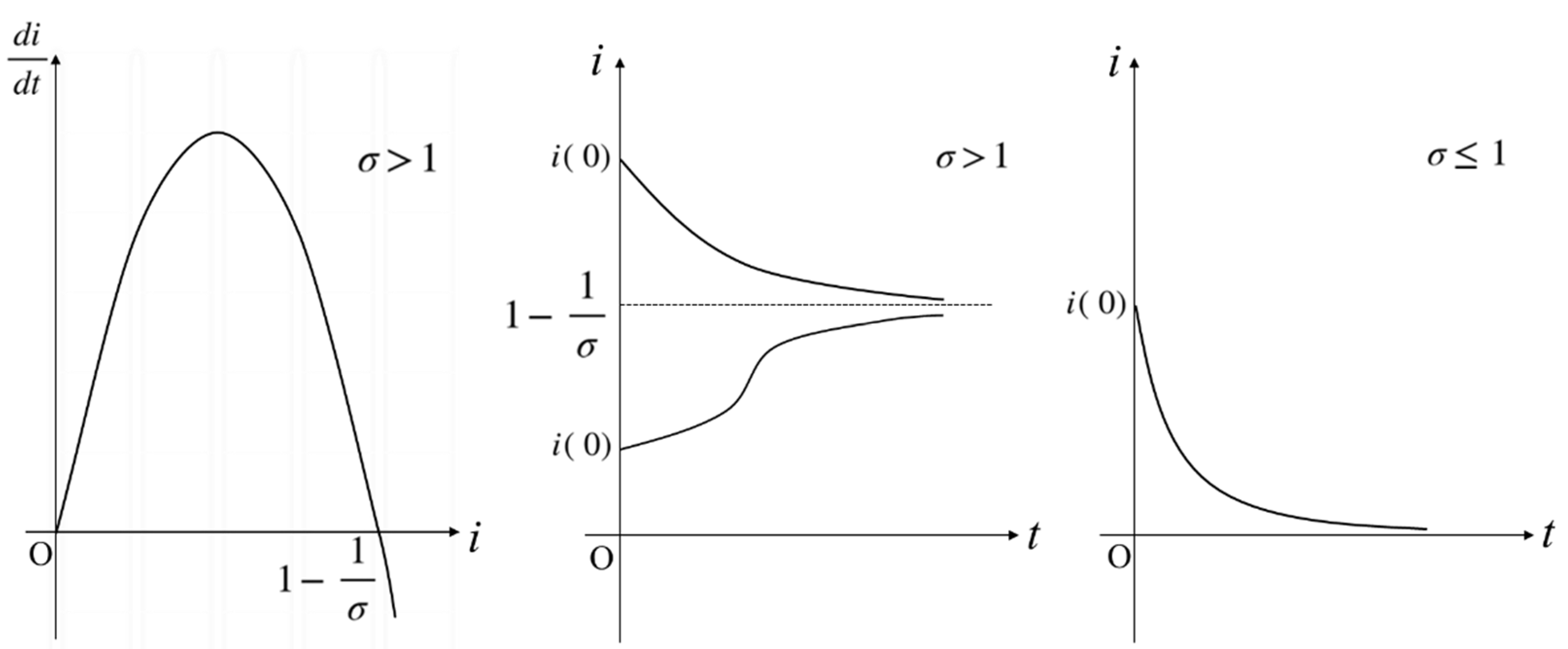

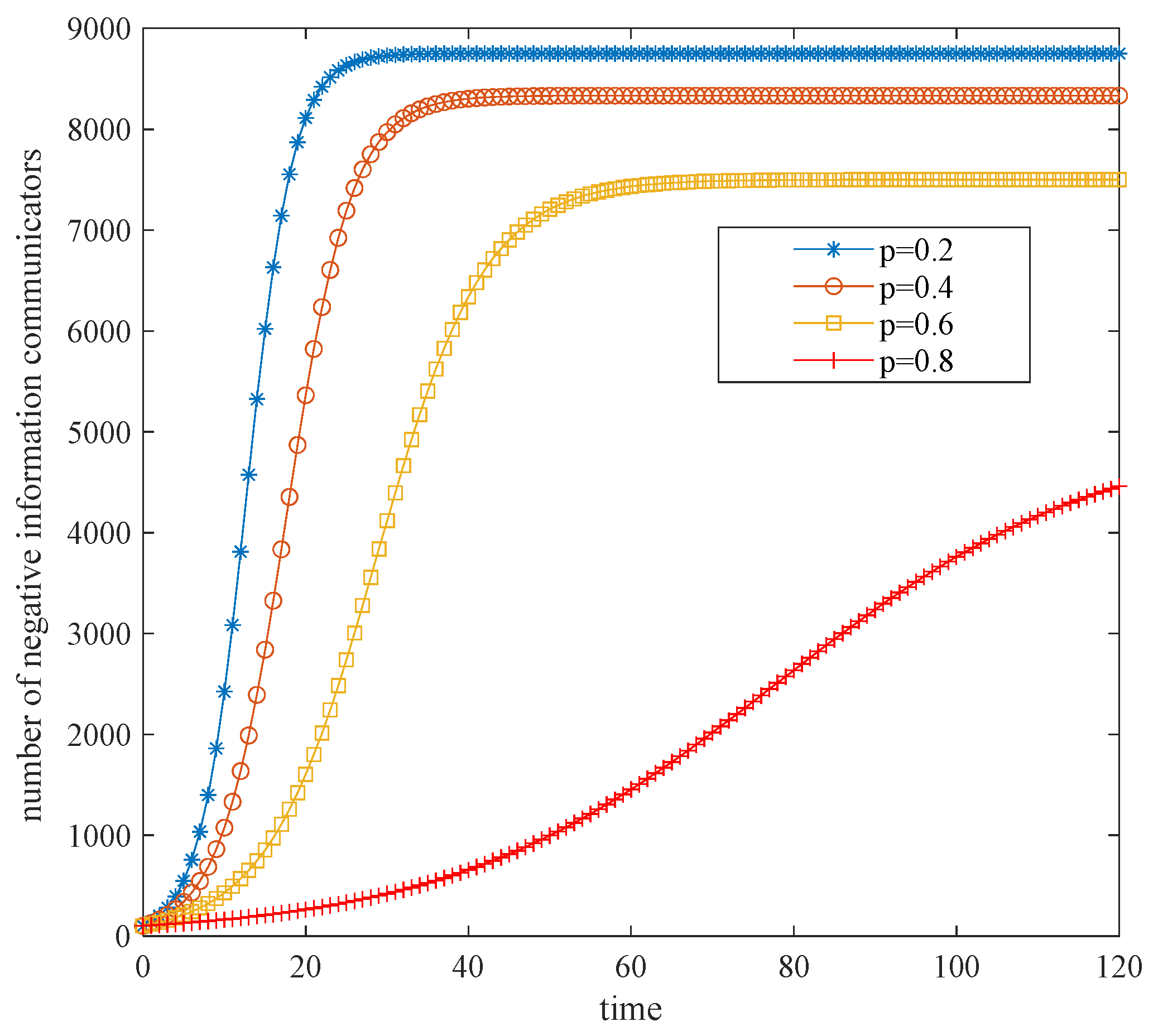
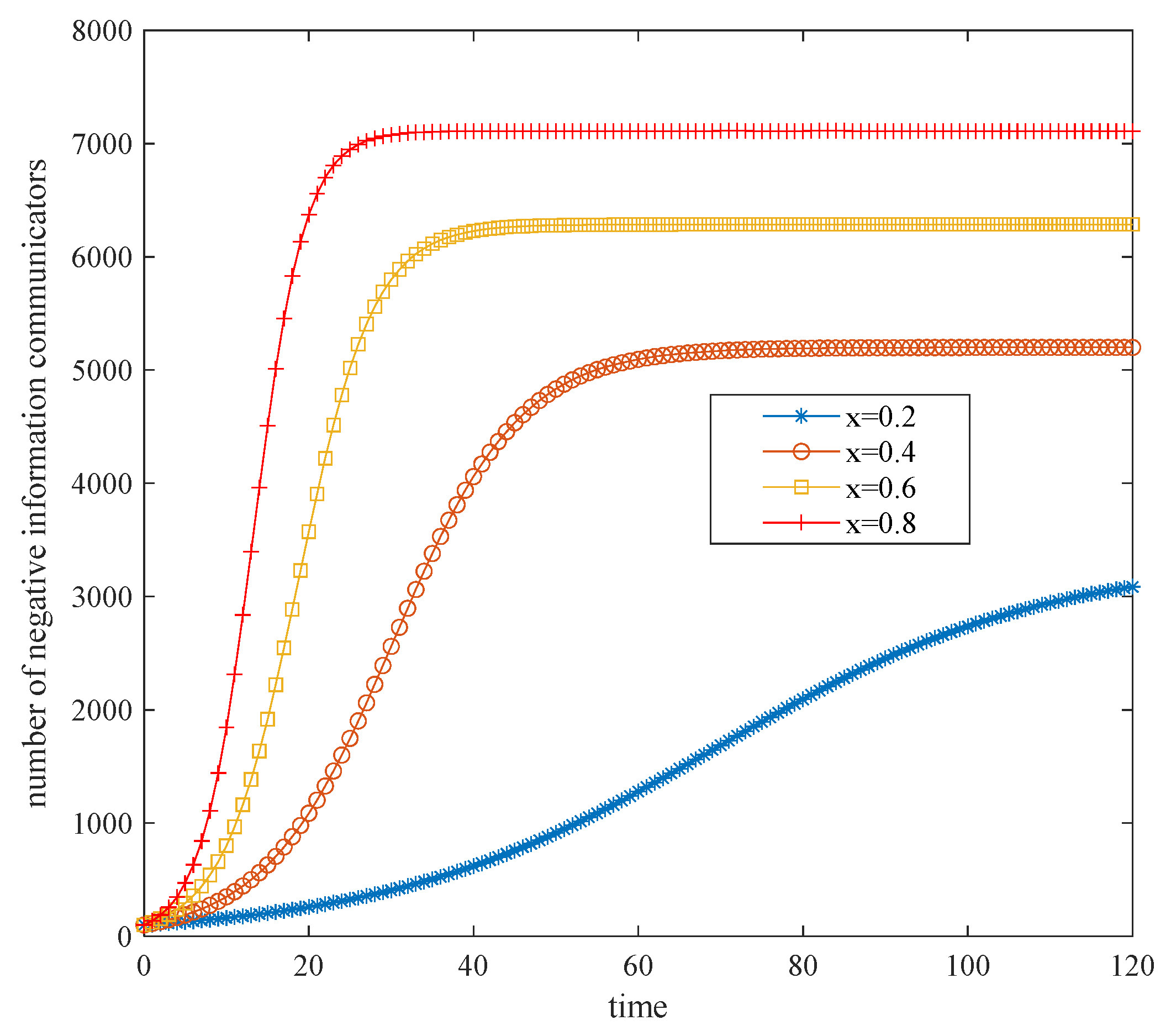
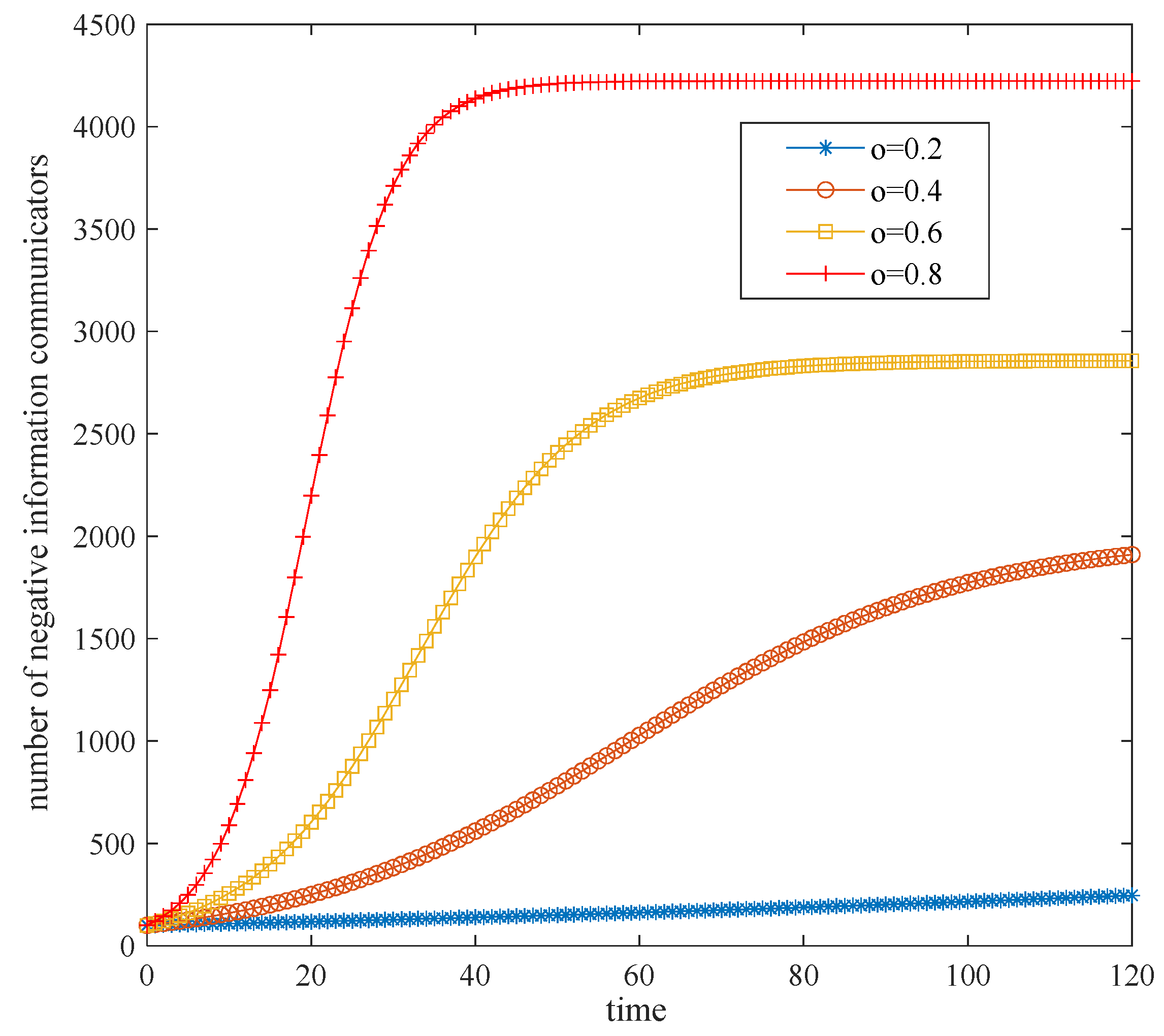

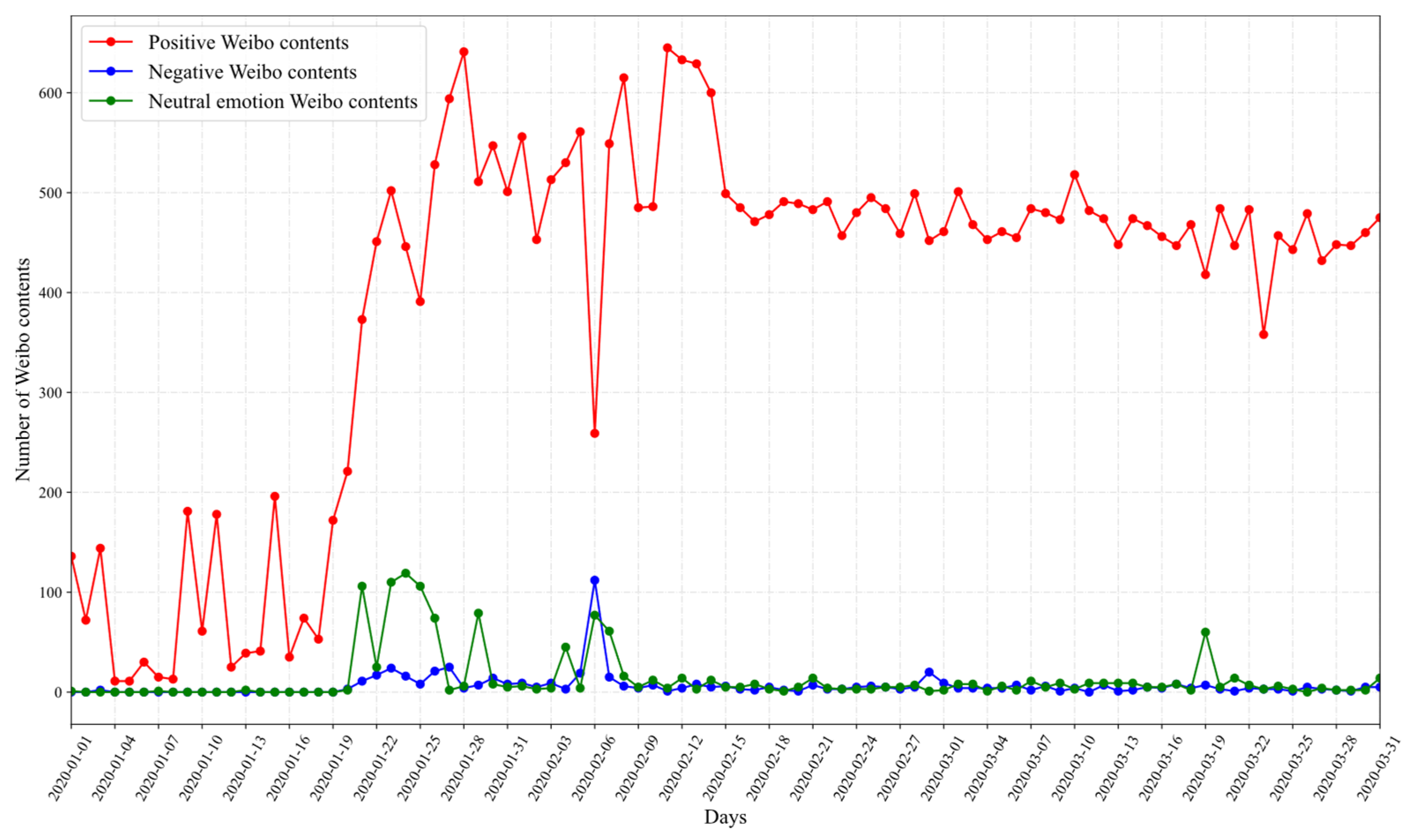

| Input: The Weibo users N = 10,000, the spread rate β = 0.3, the recovery rate γ = 0.15, the threshold = 2; Initially: For t = 0, the number of negative information communicators I(t) = 200;
Step 1: The function oed45 in matlab is adopted to solve the Equation (3); Step 2: Calculate i(t) for each time step; Step 3: Calculate I(t) fot each time step (I(t) = i(t) × N); Output: I(t). |
| Number | Node Name | Centrality | Number | Node Name | Centrality |
|---|---|---|---|---|---|
| 1 | People’s Daily | 888.333 | 13 | China Comment | 130.000 |
| 2 | State-owned Xiaoxin | 630.500 | 14 | Boss Hookup | 106.000 |
| 3 | Changjiang Daily | 604.333 | 15 | People’s Daily Online | 88.667 |
| 4 | Weibo Government Affairs | 537.000 | 16 | Yangtse Evening Post | 82.500 |
| 5 | Healthy China | 447.500 | 17 | Central Committee of the Communist Youth League of China | 82.500 |
| 6 | CCTV News | 434.167 | 18 | Sina Hubei | 60.500 |
| 7 | The Paper | 336.000 | 19 | Pear Video | 54.000 |
| 8 | Wuhan University | 314.500 | 20 | News 1 + 1 | 54.000 |
| 9 | China Newsweek | 299.000 | 21 | Three Gorges Daily | 26.500 |
| 10 | China News | 256.000 | 22 | China Daily | 26.500 |
| 11 | Health Shanghai 12320 | 214.000 | 23 | Hubei Daily | 0.500 |
| 12 | The Beijing News we video | 159.000 |
Publisher’s Note: MDPI stays neutral with regard to jurisdictional claims in published maps and institutional affiliations. |
© 2022 by the authors. Licensee MDPI, Basel, Switzerland. This article is an open access article distributed under the terms and conditions of the Creative Commons Attribution (CC BY) license (https://creativecommons.org/licenses/by/4.0/).
Share and Cite
You, G.; Gan, S.; Guo, H.; Dagestani, A.A. Public Opinion Spread and Guidance Strategy under COVID-19: A SIS Model Analysis. Axioms 2022, 11, 296. https://doi.org/10.3390/axioms11060296
You G, Gan S, Guo H, Dagestani AA. Public Opinion Spread and Guidance Strategy under COVID-19: A SIS Model Analysis. Axioms. 2022; 11(6):296. https://doi.org/10.3390/axioms11060296
Chicago/Turabian StyleYou, Ge, Shangqian Gan, Hao Guo, and Abd Alwahed Dagestani. 2022. "Public Opinion Spread and Guidance Strategy under COVID-19: A SIS Model Analysis" Axioms 11, no. 6: 296. https://doi.org/10.3390/axioms11060296
APA StyleYou, G., Gan, S., Guo, H., & Dagestani, A. A. (2022). Public Opinion Spread and Guidance Strategy under COVID-19: A SIS Model Analysis. Axioms, 11(6), 296. https://doi.org/10.3390/axioms11060296







